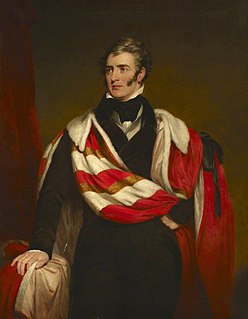Related Research Articles

Earl Nelson, "of Trafalgar and of Merton in the County of Surrey", is a title in the Peerage of the United Kingdom. It was created on 20 November 1805 for the Rev. William Nelson, 2nd Baron Nelson, one month after the death of his younger brother Vice-Admiral Horatio Nelson, 1st Viscount Nelson, the famous naval hero of the Napoleonic Wars and victor of the Battle of Trafalgar of 21 October 1805. The title is extant, the present holder being Simon Nelson, 10th Earl Nelson, who has an heir apparent. The family seat of Trafalgar House in Wiltshire was sold in 1948 by Edward Nelson, 5th Earl Nelson.

Thomas Philip de Grey, 2nd Earl de Grey, 3rd Baron Grantham, 6th Baron Lucas, KG, PC, FRS, of Wrest Park in the parish of Silsoe, Bedfordshire, was a British Tory statesman. Born "Thomas Philip Robinson", his surname changed to "Weddell" in 1803 and to "de Grey" in 1833.

The Royal Entomological Society is devoted to the study of insects. Its aims are to disseminate information about insects and improving communication between entomologists.
Events from the year 1758 in Great Britain.

The Livingston family of New York is a prominent family that migrated from Scotland to the Dutch Republic, and then to the Province of New York in the 17th century. Descended from the 4th Lord Livingston, its members included signers of the United States Declaration of Independence and the United States Constitution. Several members were Lords of Livingston Manor and Clermont Manor, located along the Hudson River in 18th-century eastern New York. The other two most influential New York dynasties of the 18th and 19th centuries were the Schuyler family and the Clinton family.

Brooks's is a gentlemen's club in St James's Street, London. It is one of the oldest and most exclusive gentlemen's clubs in the world.
References
- ↑ "Fellows of the Royal Society". London: Royal Society. Archived from the original on 2015-03-16.